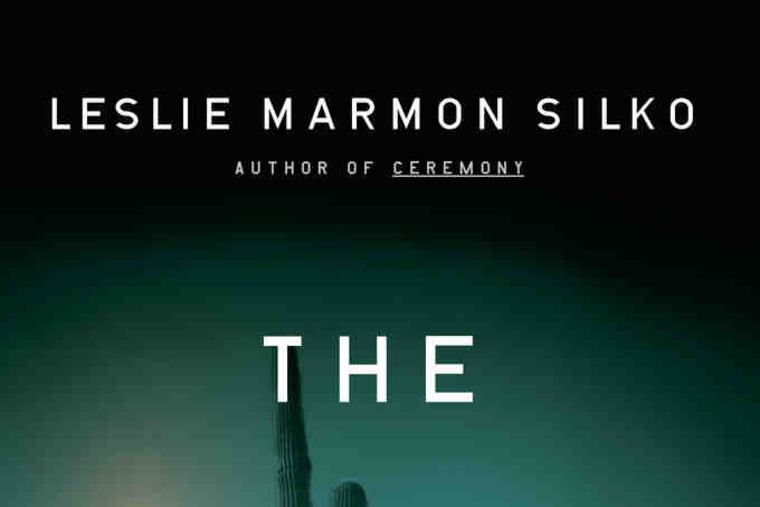'The Turquoise Ledge': Discovering the treasure hidden in the Earth
Why do human beings have such a great need to tell their stories? According to acclaimed American Indian writer Leslie Marmon Silko, the springs of narrative lie beneath our feet: "You cannot stop it," she once said in an interview, "the land speaks to you."

A Memoir
By Leslie Marmon Silko
Viking. 336 pp. $25.95.
nolead ends nolead begins
Reviewed by Helen W. Mallon
Why do human beings have such a great need to tell their stories? According to acclaimed American Indian writer Leslie Marmon Silko, the springs of narrative lie beneath our feet: "You cannot stop it," she once said in an interview, "the land speaks to you."
Silko, recipient of a MacArthur grant, is the author of Ceremony, among other novels, as well as short stories, essays, and poetry collections. Her new memoir, The Turquoise Ledge, is both an exercise in discerning the voice of the Earth and an account of the beauty and rigor of life under the skies of Arizona's Sonoran Desert, where she has lived for 30 years. It also documents her process in writing the book, where finding a turquoise bead on a lawn chair is a good omen, but a heat wave prostrates her in front of old movies on TV, not "good for writing or anything else."
The memoir's title and structure derive from early-morning walks Silko takes through the lonely arroyos and ancient trails of the Tucson mountains. "The idea," from Chapter 1,
was that the exercise and open air would help release my mind into a less self-conscious state where I could better perceive the delicacy of the light and the dawn moisture in the breeze . . . the pace of the walks helped edit the experience of the walks to the essentials.
Along the way, she developed an interest in the turquoise rocks that appeared, sometimes as if sent by unseen beings, in undisturbed places that had previously yielded no such treasures.
Bit by bit the geological and human story of these mountains emerges, along with Silko's awareness of a hidden ledge of turquoise - or is there more than one? - underneath the desert. The much-valued blue stone created by weather, water, and the accretion of minerals was traded to the ancient peoples of what is now Mexico, a region poor in turquoise, by the "ancestors" whose voices Silko occasionally discerns "singing grinding songs" in the night around her isolated house.
The book is divided into sections: "Ancestors," "Rattlesnakes," "Star Beings," "Turquoise," and "Lord Chapulin" (the Spanish word for grasshopper). Themes from one section cycle through the others, as in "Turquoise," when a neighbor's bulldozer attacks the arroyo to pry out boulders for his garden. This provokes a "strange angry energy," leading to unprecedented, fatal owl attacks on Silko's beloved macaws.
Silko is no stranger to science, grounding her observations of the desert in lively explorations of anthropology, animal behavior, geology, and weather study. She draws a parallel between post-Einsteinian physics and the cosmology of the indigenous peoples of the Americas, who traditionally viewed time not as a straight, progressive line, but as spherical, subject to movements like the ocean.
This view of time echoes throughout The Turquoise Ledge, and it opens up possibilities not often entertained in the contemporary rational mind. "More than once," Silko writes,
when I looked west toward the peak I noticed something very odd: all light, all that is visible emanating from that point appears much larger than the surrounding terrain. A magic circle of telescopic vision which could only mean some sort of discontinuity of space-time. . . . The gravity of a parallel universe very near to ours might cause refractions of the sunlight . . . .
What seamlessly follows this paragraph is a naturalist's keen observation of the small mesquite lizards and the emerald-gold gnats that hover inside the sugar-water bottles that Silko puts up for hummingbirds.
These joined episodes insist that the natural world is inherently magical. Silko is kin to anyone who seeks to understand the place of human beings in the natural order without attempting to dominate it, in the same way she and her six English mastiffs live as congenial neighbors to the many rattlesnakes, lizards, and grasshoppers that reside in cool spots outside her house. She chronicles learning to live in mutual respect with wild creatures, even the great horned owls she tries to discourage from attacking her aviary by playing "right-wing talk radio" all night long.
While Silko's ethnic heritage is mixed, she was most shaped by the culture and oral tradition of Laguna Pueblo, where she spent her childhood. The Pueblo and other Indian traditions go back at least 10,000 years, and integrating their great span of wisdom into the dynamics of modern life fuels the narrative.
The Pueblo respect for the cycles and retributions of nature supports a central theme in The Turquoise Ledge, and one we will do well to heed. The Earth itself has an active, moral heart. Silko reminds us: "As the stones from millions of years reckon it, man and machine are no more than a shadow of a mote of dust."